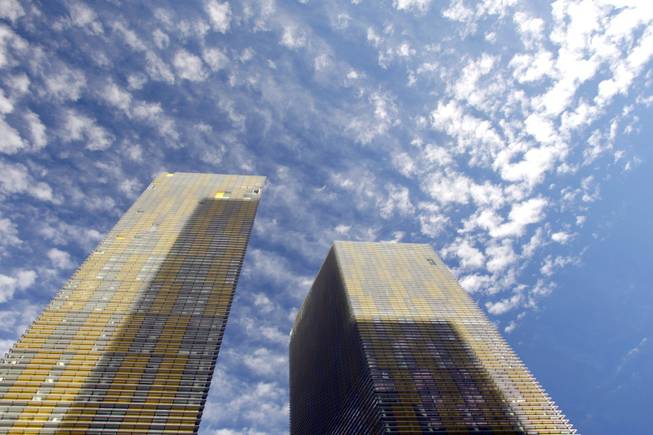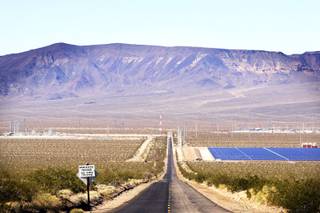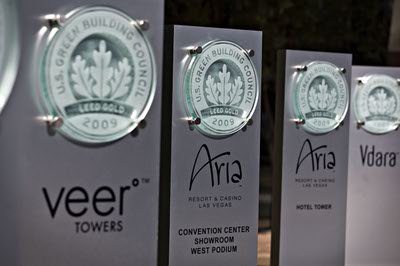
CityCenter’s Veer Towers were awarded Leadership in Energy and Environmental Design gold certifications by the the U.S. Green Building Council.
Tuesday, July 12, 2011 | 9:01 p.m.
Sun archives
- County backs proposed solar energy farm near Laughlin (7-5-2011)
- Solar project could be start of diversified economy (6-30-2011)
- Deadlines may shelve renewable energy projects (6-25-2011)
- GOP fights funding for vital Nevada renewable projects (3-3-2011)
- Reid: Solar thermal project near Tonopah to create more than 500 new jobs in Nevada (12-20-2010)
- NV Energy agrees to purchase Crescent Dunes solar power (12-22-2009)
- The cost of building a solar powered economy (8-16-2009)
- Interior bets big on Western solar energy (7-3-2009)
- Obama, Reid tour Nellis solar facility (5-27-2009)
- Solar developers shoot to beat buzzer for cash (3-22-2009)
Las Vegas bills itself as the entertainment capital of the world, but it should promote another strength that gets virtually no attention — its specialization in green architecture and construction services.
So says the co-author of a study released today by the Brookings Institution think tank in Washington on the nation’s clean economy, made up of industries that help save energy and water, support renewable resources and boost mass transit.
But green architecture jobs make up only a sliver of the clean economy. Brookings found that both the Las Vegas metropolitan area and Nevada as a whole are below average when it comes to creating jobs for the entire clean economy.
Brookings senior fellow Mark Muro said Las Vegas has one of the nation’s highest concentrations of jobs devoted to green architecture and construction versus the overall job market. There were 2,507 such jobs in Southern Nevada as of last year, producing a concentration seven times higher than the national average.
Muro, who doubles as co-director of Brookings Mountain West, a research collaboration with UNLV, said construction of the massive CityCenter on the Strip likely had a lot to do with the presence of such employers in Las Vegas. Since 2003, when there were just 157 green architecture and construction jobs in town, that employment sector has grown by more than 48 percent annually, Brookings found.
“You have an astonishing concentration of those jobs,” Muro said. “CityCenter was a massive LEED (Leadership in Energy and Environmental Design) project that brought green architecture and construction companies to the region. So you have the talent in place. You may want to market that expertise both regionally and globally to other places that are arid, like the Middle East and Asia. You should build on your strengths based on the concentrations you have.”
The global architecture firm Gensler, cited by Brookings, is an example of a green architecture and construction company that has thrived in Las Vegas. Gensler served as CityCenter’s executive architect, helping the project become the world’s largest sustainable development that stresses energy savings.
“Nevada instituted a series of tax incentives to encourage the major employers in Nevada to undertake sustainable development,” said J.F. Finn III, a Gensler principal and managing director. “Green development quickly begets green consultants and contractors to service them.”
And energy savings is often motivation enough for businesses to hire green architects.
“Most companies right now are not increasing profits, but if they can drive down costs of operations, then they can still increase their bottom line,” Finn said.
Southland Industries, a national mechanical engineering firm with about 80 employees in Las Vegas, was also cited by Brookings as an example of a green architecture and construction employer. The company performed the energy-saving air conditioning work for M Resort and also designed its water-efficient plumbing system.
Mark Crawford, the company’s principle engineer in Las Vegas, said the city has an unusually large number of big buildings for its size, which probably explains why so many green architecture and construction companies have offices in the valley.
“There’s a real appetite from casinos and hospitals for energy savings,” Crawford said. “I would like to see pilot projects where we can test technology on those buildings that looks promising.”
He said such projects aimed at increasing energy efficiency possibly could create more jobs for the valley. So would increased incentives from NV Energy and the federal government to have building owners upgrade their facilities to save on energy and water use, he said.
“There’s a healthy use of NV Energy’s incentive programs now, but if there’s a possible way to increase those incentives, they would be used too,” Crawford said.
Brookings also found that Southern Nevada employers pay better-than-average wages to clean-economy workers, $46,590 versus a major city average of $43,133. One explanation could be that Las Vegas has a relatively high percentage of clean-economy jobs that require advanced education. With 24 percent of its green workforce in science or engineering-related occupations, Las Vegas ranks second among cities in that category in the nation, trailing only Knoxville, Tenn. Those are among the highest-paying jobs in the clean economy, with average wages of $68,790.
But the Las Vegas metropolitan area devotes a minuscule percentage of its economy to clean-economy jobs, despite the high concentration of green architecture and construction work, which represents just a sliver of the clean economy.
Although Nevada has abundant solar, wind and geothermal resources, both the state and Las Vegas are barely in the middle of the pack nationally in terms of the number of green energy jobs available. Nevada, with 16,578 such jobs through the end of last year, ranked 39th among the states and District of Columbia. That included 9,797 jobs in Las Vegas, ranking the city 54th among the nation’s 100 largest metro areas.
One reason these rankings aren’t higher is the relative lack of manufacturing jobs in Southern Nevada, a phenomenon that spreads over all industries, not just clean economy work. Muro said other areas of the country, such as the Rust Belt, have a far greater pool of skilled factory workers, making them more ideal for manufacturing than Southern Nevada.
“Las Vegas has always had a service-oriented economy,” Muro said. “Nevada is not a major manufacturing center, which also depresses your exports.”
That explains why Las Vegas produces only $5,937 in exports for each clean-energy job, 87th among the nation’s top metropolitan areas.
On the bright side, Las Vegas added 3,125 clean-energy jobs from 2003 through 2010 for an annual growth rate of 5.6 percent, 23rd best among the cities. Nevada had the nation’s eighth highest green jobs growth rate during that period.
But the clean economy accounts for only 1.2 percent of the jobs in Las Vegas, compared with an average 1.9 percent among the nation’s largest metros. Statewide 1.5 percent of the jobs are in the clean economy, compared with a 2 percent average among the states
A closer look at the five other states that Brookings defines as being in the Intermountain West shows that Nevada’s 1.5 percent is equal to that of Arizona and Utah but below that of Idaho (2.7 percent), Colorado (2.2 percent) and New Mexico (2.1 percent). Among cities in the region, Las Vegas has a more intense green economy than Colorado Springs, Colo.; and Ogden and Provo, Utah; but trails Albuquerque, Boise, Denver, Phoenix, Tucson and Salt Lake City.
One way to lure and keep renewable energy developers, generators and manufacturers in Southern Nevada is to ensure that regulations and laws governing that industry are predictable, said Greg Rice, vice president of asset management at Acciona Energy North America. His company operates the Nevada Solar One power plant in Boulder City, employing 24 workers and an engineering and development staff.
If a renewable energy generation project is developed based on current pricing and other assumptions, he said there is a risk the project will later fail if there are changes to tax laws or regulations. He also said such unpredictable changes can discourage further renewable energy development.
Utility ratepayers also need to be educated that if NV Energy uses 100 megawatts of higher-priced renewable energy as part of its total power demand, “the amount billed to the average customer is negligible,” Rice said.
“There has to be a statewide renewable energy policy that is inclusive of all state agencies, developers, generators, utilities and ratepayers,” Rice said.
Better public relations could help, Finn said.
“If there was a public relations campaign for locating green businesses here that rivaled the tourism PR campaigns, that would be a big help,” he said. “We have to approach attracting businesses the same way we do tourism, and we really have to tout all our advantages to come here.”




Join the Discussion:
Check this out for a full explanation of our conversion to the LiveFyre commenting system and instructions on how to sign up for an account.
Full comments policy